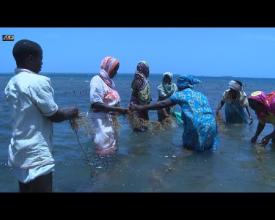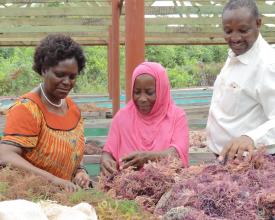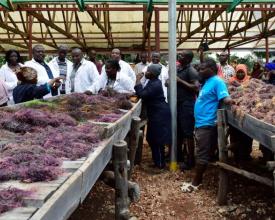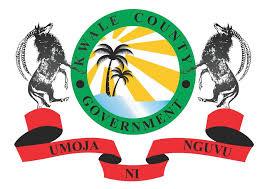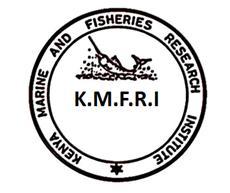
Mama Fatuma and the seaweed farming development in the south coast of Kenya

Mama Fatuma, the hard working middle aged woman living in Kibuyuni Village of Kwale County embodies the success of seaweed farming on the Kenyan coast. In a village where the predominant economic activity of fishing is a preserve of the men, Mama Fatuma encouraged fellow women to embark on seaweed farming as an alternative economic activity to wean them off over-reliance on their men folk and to enable them contribute to the family income. Following research trials and support from various sectors, seaweed farming is now earning Kibuyuni Village over USD 11,000 from the initial USD 2,000 in 2012 and beginning to thrive in various places along the south coast of Kenya and improving livelihoods through provision of additional income for families to pay school fees, meet medical costs and diversify the economy. It has also generated interest in mariculture and marine science generally among the youth in coastal Kenya.
Contexte
Challenges addressed
- Scientific data about best practices for seaweed farming unavailable. This was addressed through community collaboration with KMFRI and visit to Zanzibar;
- Lack of drying racks and open space. Modern drying racks were built through technical and financial support;
- Limited storage after harvesting and drying. This was addressed through construction of a large storage facility, with extra space for cottage industry to manufacture products such as bar soap, shampoo;
- Poor marketing of seaweed and reliance on one buyer who only came to buy occasionally, and at the price determined by him. Farmers began to process some of the seaweeds to improve its value through manufacture of various products such as soap, shampoo, baking ingredients etc. This reduced the dependancy on the sole buyer.
Emplacement
Traiter
Summary of the process
The infrastructure support coming from the Government and World Bank encouraged Mama Fatuma and her new team to farm more seaweed and protect the environment, because they rely on it. Therefore, seaweed farming is a sustainable way to use natural resources.
The infrastructure for storage enables the farmers to have control on the production and selling of the seaweed. Previously, they had to sell the seaweed to the buyer whenever he chose to come. Currently, they also have a say on the price, because they have a place to store seaweed for longer time.
The seaweed production has also triggered new local businesses, such as shops, restaurants to accommodate the many visitors etc resulting into a diverse seaweed production supply chain.
The nature of seaweed itself is easy to handle, process, store, transport, and generates high income.
Mama Fatuma has become a famous figure in Shimoni Village and beyond. She has been interviewed widely in the media and now also gives lessons to people who visit the village to learn more about seaweed farming. She was among the invited guests to the President’s State House during the National Agricultural Summit in 2016.
Building Blocks
Mama Fatuma seaweed farmer champion
When the project started as an experiment, many people were skeptical. When Mama Fatuma started harvesting and selling the seaweeds to the individual buyer, she triggered interest among some villagers. And when they started manufacturing products and selling them the interest increased drastically.
Enabling factors
- Willing to learn a new business trend, because they saw the example from a fellow woman, a peer, so they had confidence to also engage in the business, and succeed.
- Opportunity to earn their own money from selling seaweed, instead of relying on money from fishermen.
Lesson learned
Nature resources can be used for benefits, but it is not always visible or evident. For example, seaweed is not a traditional raw material for getting a livelihood. A new business model is best adopted by communities through the example of one of their own community member.
High potential for seaweed value addition on the market
- The community lives adjacent to the ocean, with seaweed as a common resource accessible to everyone without restriction.
- Seaweed farming provides diversified economic activities especially among the women. In the process it has reduced pressure, especially during times of scarcity, for relying on selling fish caught by fishermen.
- Seaweed farming and the lucrative income from sale continues to increase every year.
Enabling factors
Seaweed is free, doesn’t need fertilisers or large farming implements. It can be processed into useful various products, using local material. The income from seaweed farming is really substantial, direct and quick (no middlemen).
Lesson learned
- Dependence on a single market is neither reliable nor sustainable for seaweed farming.
- Diversification of products locally fabricated from seaweed by community members is important. It prevents piling up of seaweed when the markets are not ready to buy.
Adequate technical, infrastructure and financial support
- Free support and scientific advice from KMFRI, seed money from donor agencies and from various organizations based in Kwale County and the coastal region of Kenya.
- Regular research visits by KMFRI scientists, university students on excursions and various NGOs conducting research encourage local communities to take an interest in the ocean.
- Infrastructure development is within reach such as drying racks, storage facilities, well equipped factory create incentive for community members to embark on seaweed farming.
- Citizen science is applied. Seaweed farmers are trained on identifying the most suitable location for setting up a farm, regular measurement of water temperature, salinity and weather conditions.
Enabling factors
- The visiting researchers from NGOs and companies encourage communities to gain from the natural resources. Seaweed is valued by these institutions, as a viable alternative.
- Establishment of devolved government system in Kenya following enactment of the new Constitution enables the seaweed farmers to receive direct financial support for development from the Kwale County Government.
- Seaweed farming is part of the national government policy as key element of the blue economy strategy
Lesson learned
The application of citizen science by the local community through involving them fully in field work and teaching them simple research procedure is useful to make decisions at short notice instead of waiting for KMFRI researchers and other experts to come and assist. For example, when COVID-19 was first announced and travel restrictions imposed, the community members were able to anticipate the extreme oceanic tidal currents and flash floods from terrestrial surface runoff that threatened to destroy vast areas of seaweeds. A lot of seaweed was therefore rescued.
Impacts
- The harvest doubled from 5,204 kg in 2012 bringing income of KES 46,840.5 (USD 426) to 10,554 kg in 2018 at the cost of up to KES 263,850 (USD 2,398). The unit price has fluctuated widely from KES 9 per kg in 2012, to KES 30 per kg in 2015 for a total KES 1,277,490 (USD 11,608.36) earned by the community ;
- The sale of products from seaweed was substantially improved when the community was given space to sell their products to a wider market during cultural events in Kwale and at trade fairs such as the Kwale Cultural Show, International Fairs in Mombasa and Nairobi etc.
-
Seaweed farms became learning sites for students from schools and universities, as well as tourist attractions for local and foreign visitors;
-
Upscale of seaweed farms from Kibuyuni to 11 other villages along the south coast of Kenya;
-
Women and youth empowerment through engaging in a successful business model
Beneficiaries
- Women seaweed groups
- Individual residents
- Other community-based organisations
- Students from schools and universities who learn about seaweed production
Sustainable Development Goals
Story
Kibuyuni Seaweed Self-Help Group (SHG) in Shimoni, Kwale County was established by the community in 2010. This was after 2 years of trials of seaweed farming conducted by the Kenya Marine and Fisheries Research Institute (KMFRI). The original membership of the group was 113, with the majority (75%) being women. Initially they started by selling a kg of seaweeds at the price of KES 9 (100 KES = 1 USD), thereafter the price increased to KES 15 and it has currently almost tripled to KES 25.
In recognition of the community efforts led by Mama Fatuma and the Kibuyuni SHG, the County Government of Kwale and the Fisheries Ministry in the National Government have funded the construction of a storage facility for preserving large quantities of seaweed for a long time.
KMFRI has posted a field scientist in Kibuyuni to work closely with Mama Fatuma and the other community members. Additionally, KMFRI is in the process of establishing a research station with laboratories and offices, which will serve the entire south coast region of Kenya.
Following the inception of Blue Economy in Kenya in 2018, 4 more institutions joined KMFRI in supporting the activities of the group. These included Kenya Industrial Research Development Institute (KIRDI), Kenya Industrial Patent Institute (KIPI), Kenya Bureau of Standards (KEBS) and Brand Kenya – which articulates Kenya’s Vision 2030 aspiration. KEBS was involved to ensure that one of the main locally manufactured products, Seaweed soap maintains its high quality and reaches both the local and national markets.
Various other communities in the south coast of Kenya are emulating Shimoni SHG. This is witnessed through extension of seaweed farming to other places such as Mkwiro, Gazi, Funzi, Nyumba Sita, Tumbe, Mtimbwani, Mwambao, Fikirini, Jimbo and Munche. KMFRI is carrying out experiments in these new sites to determine viability, and also providing regular technical support and building the capacity of youths in these areas through training on seaweed farming, drying, storage and extraction processes.

